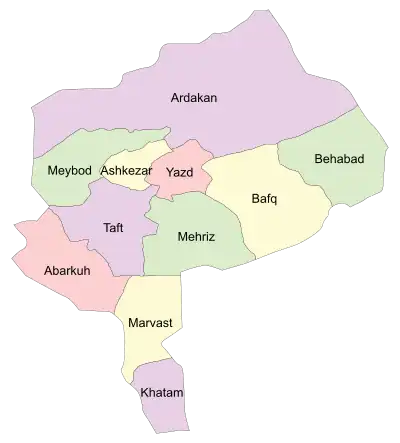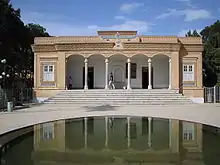Yazd province
استان یزد | |
|---|---|
 Clockwise from top left: Meybod as seen from Narin Qal'eh, Tower of Silence outside Yazd, Amir Chakhmaq Mosque and Kharanaq in Ardakan County. | |
 Location of Yazd province in Iran | |
| Coordinates: 31°53′41″N 54°21′25″E / 31.8948°N 54.3570°E | |
| Country | Iran |
| Region | Region 5 |
| Capital | Yazd |
| Counties | 13 |
| Government | |
| • Governor-general | Mehran Fatemi |
| • MPs of Assembly of Experts | Abolghasem Wafi Yazdi |
| • Representative of the Supreme Leader | Mohammad Reza Naseri Yazdi |
| Area | |
| • Total | 76,469 km2 (29,525 sq mi) |
| Population (2016)[1] | |
| • Total | 1,138,533 |
| • Density | 15/km2 (39/sq mi) |
| Time zone | UTC+03:30 (IRST) |
| Main language(s) | Persian |
| HDI (2017) | 0.824[2] very high · 5th |
| Website | ostanyazd.ir |
Yazd province (Persian: استان یزد, Ostān-e Yazd) is one of the 31 provinces of Iran. It is in the center of the country, and its capital is the city of Yazd. In 2014, it was placed in Region 5.[3] The province has an area of 76,469 km2.
At the time of the National Census of 2006, the population of the province was 958,323 in 258,691 households.[4] The 2011 national census counted 1,074,428 people living in 309,749 households.[5] At the most recent census of 2016, the population of Yazd province had risen to 1,138,533 in 340,657 households, by which time Tabas County had been separated from the province and joined South Khorasan province.[1]
Geography

Yazd province with the area of 129,285 km2 (49,917 sq mi)[6] is situated in an oasis where the Dasht-e Kavir desert and the Dasht-e Lut desert meet. The city itself is sometimes called "the bride of the Kavir" because of its location, in a valley between Shir Kuh, the tallest mountain in the region at 4,075 m (13,369 ft) above sea level, and Kharaneq. The city proper is located at 1,203 m (3,947 ft) above sea-level, and covers 16,000 km2 (6,200 sq mi).
Mountains of Yazd
- South- and Southwestern Mountains
This group is wider than the other ridges and includes Shir Kuh
- Eastern Mountains
They are located in the east of Yazd province with the highest peaks being Bon Lokht (3002)
Administrative divisions

| Administrative Divisions | 2006[4] | 2011[5] | 2016[1] |
|---|---|---|---|
| Abarkuh County | 42,610 | 46,662 | 51,552 |
| Ardakan County | 66,900 | 77,758 | 97,960 |
| Ashkezar County | 28,072 | 33,192 | 32,566 |
| Bafq County | 51,507 | 41,876 | 50,845 |
| Behabad County1 | — | 15,331 | 17,221 |
| Khatam County | 31,695 | 35,158 | 36,562 |
| Marvast County2 | — | — | — |
| Mehriz County | 43,363 | 44,126 | 51,733 |
| Meybod County | 70,728 | 82,840 | 99,727 |
| Tabas County3 | 63,047 | 69,658 | — |
| Taft County | 45,357 | 45,145 | 43,893 |
| Yazd County | 515,044 | 582,682 | 656,474 |
| Zarach County4 | — | — | — |
| Total | 958,323 | 1,074,428 | 1,138,533 |
| 1Separated from Bafq County 2Separated from Khatam County 3Joined South Khorasan province 4Separated from Yazd County | |||
Cities
According to the 2016 census, 971,355 people (over 85% of the population of Yazd province) live in the following cities: Abarkuh 27,524, Ahmadabad 6,046, Aqda 1,754, Ardakan 75,271, Ashkezar 19,123, Bafq 45,453, Bafruiyeh 6,939 Behabad 9,232, Hamidiya 51,793, Herat 13,032, Khezrabad 535, Marvast 9,379, Mehrdasht 8,097, Mehriz 34,237, Meybod 80,712, Nadushan 2,351, Nir 1,740, Shahediyeh 18,309, Taft 18,464, Yazd 529,673, and Zarach 11,691.[1]
Gallery


References
- 1 2 3 4 "Census of the Islamic Republic of Iran, 1395 (2016)". AMAR (in Persian). The Statistical Center of Iran. p. 21. Archived from the original (Excel) on 18 November 2020. Retrieved 19 December 2022.
- ↑ "Sub-national HDI - Area Database - Global Data Lab". hdi.globaldatalab.org. Retrieved 13 September 2018.
- ↑ "همشهری آنلاین-استانهای کشور به ۵ منطقه تقسیم شدند (Provinces were divided into 5 regions)". Hamshahri Online (in Persian). 22 June 2014 [1 Tir 1393, Jalaali]. Archived from the original on 23 June 2014.
- 1 2 "Census of the Islamic Republic of Iran, 1385 (2006)". AMAR (in Persian). The Statistical Center of Iran. p. 21. Archived from the original (Excel) on 20 September 2011. Retrieved 25 September 2022.
- 1 2 "Census of the Islamic Republic of Iran, 1390 (2011)" (Excel). Iran Data Portal (in Persian). The Statistical Center of Iran. p. 21. Retrieved 19 December 2022.
- ↑ Statoids.com

